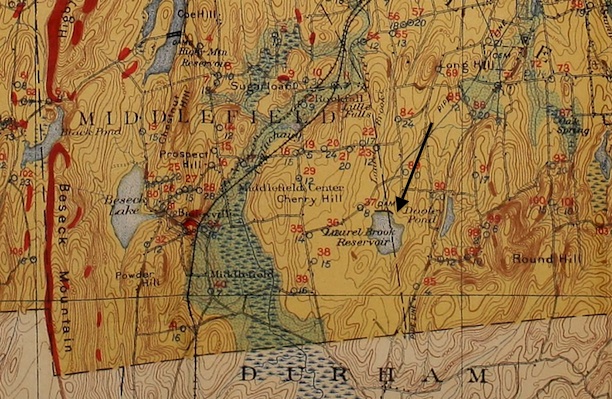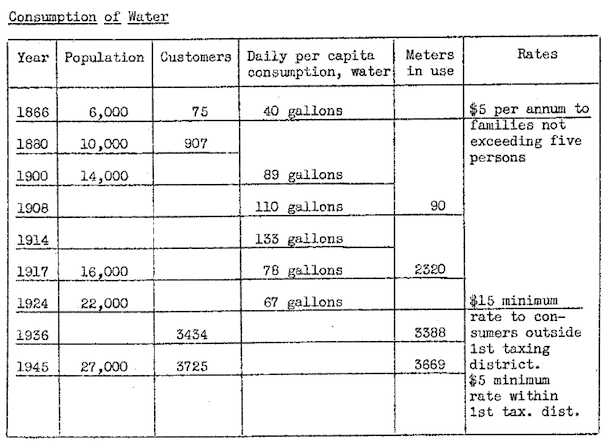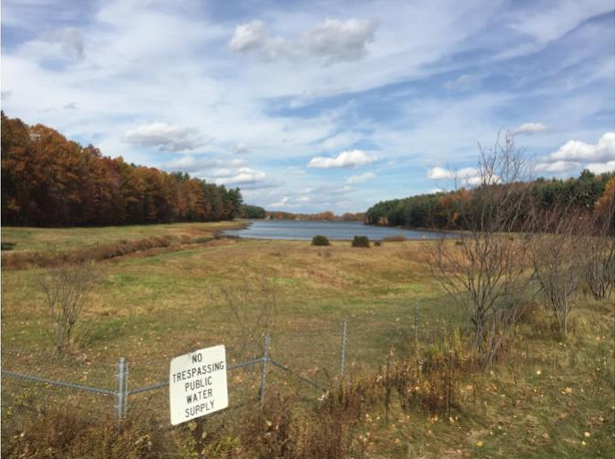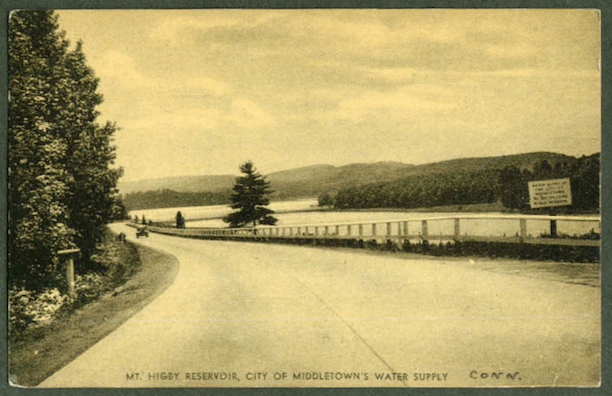By Andrew Jacono
Water has been an integral part of the development of Middletown since its founding over 350 years ago. The city’s inhabitants always required a steady supply of clean water, not just for drinking, but also for sanitation, transportation, and sewage disposal. Though these water resources drove Middletown’s growth, an efficient system for harvesting and transporting water from nearby reservoirs only emerged in the mid-19th century. These reservoirs, specifically the Laurel Brook and Mount Higby Reservoirs, allowed Middletown to flourish.
The Laurel Brook and Mount Higby Reservoirs
Middletown began using reservoirs to supply its residents with water in 1866. The first source, the Laurel Brook Reservoir, resides just south of Middletown. Though it is small and seemingly inadequate for a large community, it happened to be the perfect size to provide drinking water for the humble population of 3,500 people that resided in the area around 1860.

Detail showing Laurel Brook Reservoir located on the Middlefield, Middletown, Durham border from the “Map of the Meriden Area, Connecticut: Showing glacial deposits, rock outcrops, and the location of typical wells and springs” by G. A. Waring, 1920.
Because Middletown’s population nearly doubled in the next decade, however, the Laurel Brook Reservoir only proved adequate until around 1874. Residents and water commissioners alike complained that the reservoir did not provide enough pumping power. The city commission for public works remarked that the pipes from the reservoir were too small to pump the required amount of water and that residents extracted water too liberally—water consumption exceeded initial expectations by 400 percent. In 1892, after much deliberation, the town drafted a contract to create the 137-acre, 375-million-gallon Mount Higby Reservoir and installed pipelines of greater quality. According to the local water commission, this effectively tripled the local water supply.

Table indicating the changes in Middletown’s consumption of water over time from the Report on the Water System and the Sewage Disposal Plant of Middletown, Connecticut, June, 1946
The town used both reservoirs in tandem through the rest of the 1800s and into the mid-1900s. During this time, however, problems arose regarding the cleanliness of the water. Contamination tests taken in 1900 showed that bacteria contaminated about 6.9 percent of the Laurel Brook supply. The contamination probably arose from runoff, animal waste, and the hasty disposal of human refuse; the Mount Higby Reservoir had an approximately 3.9 percent contamination rate. For the next few years the water commissioners awaited clearance from the townspeople to treat the water with copper sulfate, but it was not until 1914 that officials deemed the method necessary and successfully put it into practice.
By 1940, when the population reached 26,500 people, the reservoirs faced another problem. Supplying water for sewage, fire hydrants, drinking purposes, and residential life (swimming pools, gardening hoses, etc.) became difficult, and in 1941, officials barred Middletown residents from using water for purposes other than drinking. To remedy the problem, the water commission installed meters to limit consumption, and eventually the situation eased.
But by the mid-1950s officials once again deemed the Laurel Brook reservoir inadequate (as it faced numerous problems with its pipe system) and they officially closed it down. The only significant water source then became the Mount Higby Reservoir, and to increase the supply, the city constructed a series of wells that helped to pull in more water.
Reliable Water Supplies Foster Growth

Mount Higby Reservoir, 2015 – Andrew Jacono
In 1964, town commissioners predicted a surge in population over the course of the next 40 years because of the stability of the local water infrastructure and the expansion of services such as fire hydrants and indoor plumbing. By 1985, Middletown supported a population of over 39,000 people, consuming around 3.8 million gallons of water per day—around 1.6 billion gallons per year. Water sources treated over 1.3 billion gallons of sewage, and the city planned to strengthen the water grid to provide pressure to less-industrialized parts of the city.
The Mount Higby Reservoir remains in use today, and although Laurel Brook is not officially cleared for usage, the town still taps into it in emergency situations. Access to both reservoirs remains highly restricted, however.
Access to a clean and reliable supply of water helped drive changes to the Middletown landscape over the past 350 years. From simple reservoirs to a system filled with wells and complex piping, water played an important role in the growth of the city both in a residential and commercial capacity. Today this evolving system supports a population of almost 50,000 people.
Andrew Jacono authored this piece while a student at Wesleyan University as part of a class project in environmental history.









